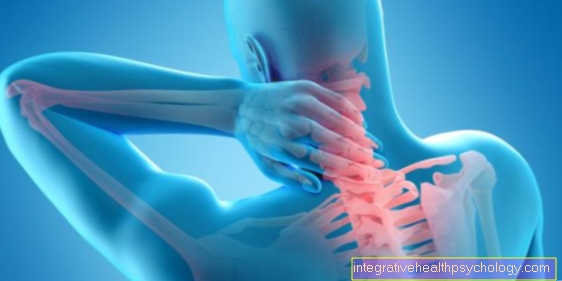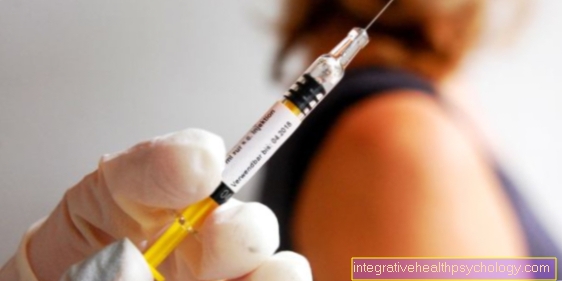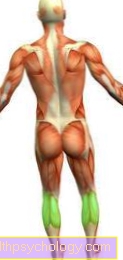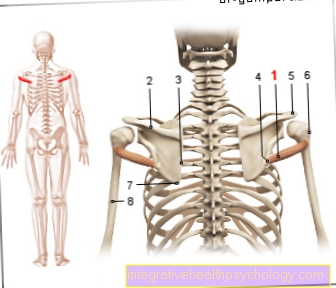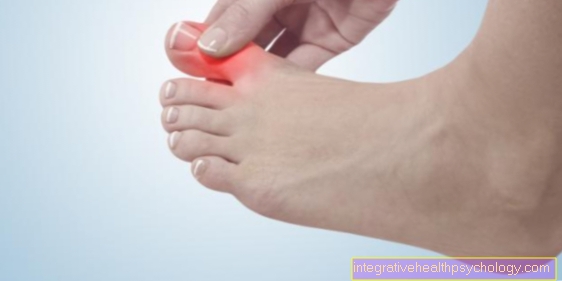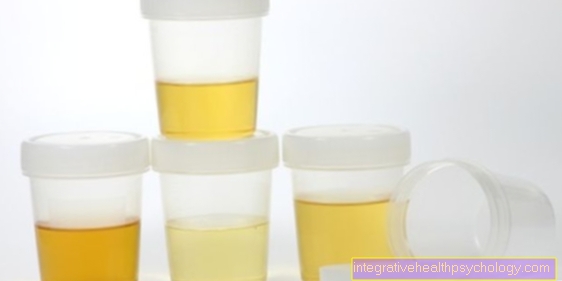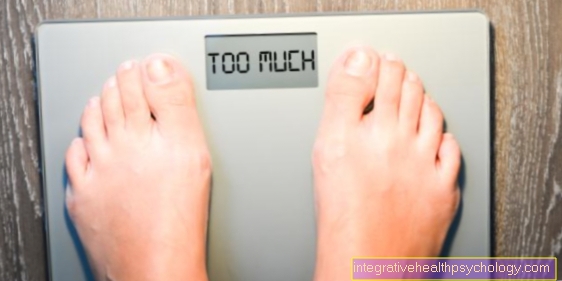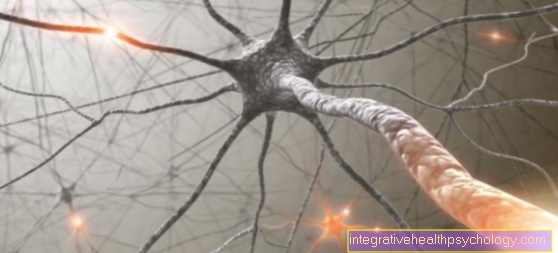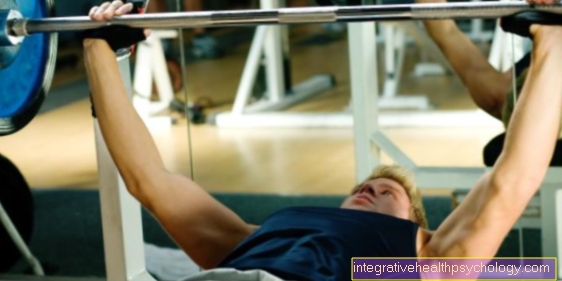Sweating
definition
Sweats are sudden reactions of the body to regulate the core body temperature or as an additional symptom during shock symptoms. The core body temperature is around 37 ° C, below this temperature the body guarantees optimal fulfillment of its tasks. It is regulated by parts of the nervous system that directly stimulate the sweat glands (called the sympathetic nervous system in technical terms). If the internal core temperature exceeds 37 ° C due to excessive heat supply or if the body is in shock, the sweat glands are stimulated by the nervous system to secrete fluid through the surface of the skin.
Read more on this topic: Sweat

causes
The causes that lead to sweating are either a deliberate release of heat from the body to regulate the core body temperature, or a reaction of the sweat glands to the extreme stimulation by the involuntary nervous system (here the sympathetic nervous system) during a state of shock. By excreting fluid through the skin, the body not only gives off heat, but also simultaneously cools the body from the outside through the beads of sweat that form on the surface.
The cause can be anything that stimulates the body to produce heat or to fight and flee (active sympathetic nervous system): sport, spicy food, increased immune defenses (fever), overactive thyroid, fear, danger, escape reaction and the survival of the body secure (shock state). All of these situations and causes stimulate the involuntary nervous system to, among other things, activate the sweat glands. Depending on the cause, additional metabolic reactions are stimulated more or less at the same time. Not only the sweat glands, but also other organs are more or less stimulated. A sweat breakout leads to cold sweat breakouts in a dangerous situation, while a sweat breakout is warm during sport. This could be due to how strongly the sympathetic nervous system is activated. In a state of shock, small vessels in the skin are also closed, which can then no longer heat the emerging sweat. During sport or during active exercise, the sympathetic system kicks off the energy metabolism and can trigger a sweat if the desired body temperature of 37 ° C is exceeded. With excessive stress, e.g. During a frightening event, the body's stress reaction and thus its nerve endings in the sweat glands are activated. This stress reaction is controlled without our will, that is, the sympathetic nervous system is not deliberately influenced. A system that runs "in the background" so to speak, i.e. We do not perceive its functions very much or not at all. So whether we sweat or not, we cannot prevent, as it is supposed to protect the body from overheating, whether you want to or not.
Read more on this topic: Autonomic Nervous System such as Causes of Hot Flashes
thyroid
The thyroid really fires up our metabolism. It determines a large part of our energy turnover and fuels the combustion processes of nutrients. If it is overstimulated, as is the case with hyperfunction, its stimulating drive often becomes a burden, as the organism then runs at full speed. The heat production is started and those affected react very sensitively to additional heat from outside or in the event of further illnesses. Therefore, people with an overactive thyroid gland often break out in sweats and sweat more.
At night
Many people who sleep under a blanket that is too thick or at a high room temperature are affected by sweats at night. Although this does not indicate illness, it can disrupt sleep and lead to fatigue and exhaustion the next day. Night sweats can also occur as a side effect of some medications. Above all, psychotropic drugs, stimulants, tablets to lower high blood pressure or hormone preparations should be mentioned here. To name a few specific preparations, these are, for example, antidepressants or neuroleptics, birth control pills, L-thyroxine for taking thyroid hormones and Cortisone in inflammatory processes. This can be particularly pronounced if the medication is taken shortly before going to bed. Unfortunately there are also cancers such as malignant skin tumors (Malignancies), which can lead to night sweats. If you also have a fever and weight loss, this should definitely be examined by a doctor. Stimulants such as alcohol, cigarettes and drugs can have a negative or stressful effect on the body during sleep; especially if they are consumed just before bedtime. These too can lead to night sweats.
You might also be interested in: Skin Cancer Symptoms
During menopause
The menopause (climacteric) describe the transition in time from full sexual maturity to the hormonal standstill of her ovaries. These can stretch over an entire decade and usually affect women from the age of 45 and end when they reach the age of 55. Of course, these are individual processes that affect the duration and timing of the last menstruation (menopause) vary and are accompanied by symptoms to varying degrees. In simple terms, the production of hormones, especially estrogen, decreases, which means that new egg cells can neither mature, jump nor develop. This makes natural fertilization / pregnancy impossible and other functions carried out by estrogen fail. With the withdrawal of estrogen, the heat balance is also poorly or worse regulated. Therefore, estrogen deprivation very often leads to sweats and hot flashes. Women then sweat in situations in which they should actually feel cold, such as in winter under a thick winter jacket in freezing temperatures in the cold, or for no apparent reason because the temperatures are objectively considered to be room temperature. The period before menopause in particular is characterized by sweating.
You might also be interested in: Menopausal sweating
During pregnancy
What is still perceived as pleasant at the beginning of pregnancy can quickly become a burden from mid-pregnancy. The woman's organism adjusts to pregnancy as soon as the egg cell has been fertilized. The body then increases the performance of the cardiovascular system in order to provide more blood to itself and its organs. This is mainly noticeable in the skin of the feet, hands, legs and arms. This creates a pleasant warm feeling, which can turn into sweats after a few months of pregnancy. Because with every additional month in which the child and its pregnancy-maintaining organs grow, more energy has to be expended to set the woman's body in motion. This leads to an outbreak of sweat more quickly, especially during active movement.
During the meal
There are two reasons why eating can be a sweaty affair. For most people, a hot meal is enough; for others, really spicy food makes beads of sweat on their foreheads. The reasons for breaking a sweat are to be considered differently, as they are perceived in completely different ways by the organism. It almost goes without saying that a hot meal makes you sweat. Everything that adds heat to the body, although the body is already set to a comfortable temperature (approx. 37 ° C), the organism wants to cool down again as quickly as possible and therefore starts to cool sweating - triggered by feedback mechanisms that are interconnected at the level of the nervous system. The sweat glands are activated by nerve fibers and give off heat to the outside via liquid, or thus cool the skin from the outside.
It is similar with spicy food, but a little different. Because spicy food is known to be not a real taste experience, but a pain. The pain threshold is different for each person. Pain stimuli in themselves lead to the nervous system being stimulated to stimulate the sweat glands, just like with heat. At the same time, some sharp substances trigger direct heat stimuli, such as the Capsaicin in the pepper, as they open channels from nerve endings that convey warmth.
From a cold
Often a cold is accompanied by a fever or vice versa. The immune system is boosted to destroy the causative viruses. This defense mechanism often triggers a fever, depending on how hard the immune system has to fight. Fever is necessary to kill the pathogens that have attacked the organism. But at the same time, the fever also puts the body in an unfavorable position, as it can only function effectively at 37 ° C. The heat balance is disturbed, more energy is required, the body wants to regulate the internal temperature down in order to be able to function fully. Heavy sweating then occurs, especially with additional heat from outside.
After alcohol
The Sulfites in alcohol can occasionally lead to intolerance reactions.
Intolerance reactions can manifest themselves as a sweat. However, this cannot be explained more precisely at the current scientific point in time. Affected people who experience pauses in breathing at night (Sleep apnea) suffer from alcohol consumption. If breathing stops, the body can react with a sweat.
Since alcohol consumption also stimulates the cardiovascular system and thereby stimulates blood circulation in the skin, even a small amount of alcohol can lead to sweating, depending on your sensitivity.
diagnosis
To call the sweat a diagnosis would be medically wrong. It is an accompanying symptom of many underlying diseases, especially those that are related to the heat balance and metabolism. So thyroid diseases, cardiovascular diseases, etc. In addition, it is to be seen as a reaction to different causes that activate the involuntary nervous system (here the sympathetic system) and thus the sweat glands.
Concomitant symptoms
Basically, the accompanying symptoms depend on the underlying diseases or causes that cause the sweat. Classic accompanying symptoms in a sudden outbreak of sweat, without an underlying disease, heart palpitations, cravings, centralization (the accumulation of blood in the middle of the body), tremors or nausea (see subsections for more details).
With dizziness and tremors
Dizziness paired with outbreaks of sweat and possibly occurring tremors can be caused by hypoglycaemia. Both in diabetics and in people who e.g. who have just vomited can suffer from severe circulatory problems, which are then mainly manifested in cold sweats and dizziness. If there is an infection, e.g. of the upper respiratory tract, such as the sinuses, this can also lead to sweating and simultaneous dizziness. But stress can also cause the symptoms in combination, especially in people who are very sensitive to stressful situations.
A sweat paired with dizziness and tremors are also part of the (classic) shock symptoms. Shock can be due to various causes, e.g. from the loss of a large amount of blood, a severe allergic reaction, e.g. a wasp sting, or a psychogenic state of excitement. What they all have in common is that the blood pressure drops, the blood is redistributed to the center of the body, the sweat glands are activated, and the hands and feet become cold. These and other processes lead to the symptoms mentioned.
With nausea, stomach pain and a racing heart
Sudden sweating combined with nausea and / or a racing heart may indicate a Heart attack or a narrowing of the coronary arteries. The coronary arteries supply the heart muscle with blood and, if narrowed, can lead to chest pain, upper abdominal pain and reduced performance. Sweats occur particularly under physical exertion, often combined with nausea, radiating pain in the upper abdomen, arms, lower jaw and a racing heart. The reason for this is the stimulation of the involuntary nervous system (sympatheticus) in order to compensate for the deficits that a narrowed coronary artery brings with it. Keyword - undersupply of the muscle with blood and thus reduced oxygenation. Since the system not only influences the heart and blood vessels locally, but also If the sweat glands are also innervated, the symptoms appear together.
therapy
One way to contain sweat breakouts is to use Aluminum chlorides as they are partly contained in pharmacy-only deodorants. They can be applied locally, e.g. Very effective protection in the armpit region as protection against annoying moisture (with regular use). Otherwise, the "classic" sweats (as described in this article) are not treated medically (surgically), as they represent a necessary protection and a vital reaction of the body.
Applications for the permanent elimination of sweats such as the clinical picture of Hyperhidrosis has various surgical, minimally invasive interventions, here are a few examples. The now successfully used method of administering botulinum toxin (Botox®) in the corresponding area (e.g. the armpits). This is injected under the skin with a syringe in liquid form. Several treatments are necessary, but after a few applications they can ensure that the treated area is completely free of sweat. This method of treatment provides about six months of protection before it has to be repeated.
A suction of the sweat glands, e.g. in the armpit, is also possible. For this purpose, a small skin incision is made through which the sweat glands can be suctioned off with special cannulas. The effect can be felt immediately.
A permanent solution to the freedom from perspiration on the head, hands, armpits and feet is a kind of clamping of the sympathetic nerve fibers near the spinal cord. Here a clip is "clipped" to the nerve structure that supplies it, which prevents impulses from being passed on (sympathetic block).
Duration and forecast
As a rule, sweats appear acutely and subside after a few minutes. If they occur more frequently and last for a longer period of time, it is no longer a classic sweat. Frequent and persistent sweating should be clarified by a doctor. This can include the clinical picture of a Hyperhidrosis (frequent, excessive sweating) hide. If the sweats are of psychological origin, psychotherapy can help.
On the head and on the hands
Localized outbreaks of sweat on the hands or head are rather rare, unless there is an overactive sweat gland in the area mentioned. Then, however, it is no longer the symptom of the outbreak of sweat, but the clinical picture of the Hyperhidrosis palmaris (Palms) or the Facial hyperhidrosis (Head / face). They describe excessive, regular sweating of the hands and the head area. Additional consumption of sweat-inducing stimulants such as caffeinated drinks can further contribute to a permanent stimulation of the sweat glands.
However, some of those affected also literally feel “sweat on their foreheads” when they find themselves in a situation that causes fear or stress. Why in these affected people the outbreak of sweat is located exactly on the palms of the hands, forehead or temples and not in the armpit can not be explained medically. One possible explanation is that those affected have a higher density of or a higher sensitivity of the sweat glands in certain parts of the body.



